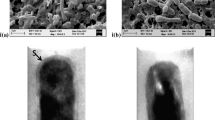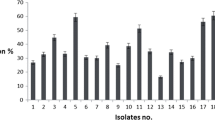Abstract
Lactobacillus reuteri Lr1, isolated from healthy horses, remained viable after 2 h at pH 2.0 and in the presence of 1.5 % (w/v) bile. Strain Lr1 survived passage through the equine gastro-intestinal tract (GIT). However, no viable cells of L. reuteri Lr1 were detected on the third day after administration, suggesting that the strain did not colonise the GIT for longer than two days. Strain Lr1 adhered to non-viable, but not to viable, buccal epithelial cells in vitro. Adherence of strain Lr1 to buccal epithelial cells increased 25 % after treatment of the bacterial cells with pepsin. Treatment with pronase prevented the adhesion to epithelial cells. This suggested that specific proteins on the cell surface of L. reuteri Lr1 are involved in adhesion to epithelial cells. Strain Lr1 aggregated with Clostridium difficile C6, isolated from the GIT of a horse that died from severe colic. Adherence of C. difficile C6 to epithelial cells declined from 60 % to 3 % when challenged with L. reuteri Lr1 and the number of viable clostridia decreased tenfold during dosage. Red blood cell, haemoglobin and haemocrit levels were significantly (P ≤ 0.05) lower after dosage with L. reuteri Lr1. Cholesterol and glucose levels were mildly elevated for one day during dosage, but decreased significantly thereafter to levels similar than before dosage. Genes encoding adhesion to collagen, production of aggregation substances, cytolysin and β hemolysin III, resistance to vancomycin A, B and C, and gelatinase activity were not detected, suggesting that L. reuteri Lr1 is a potential probiotic that may be used to control C. difficile cell numbers in the GIT.





Similar content being viewed by others
References
Al Jassim RAM, Scott PT, Trebbin AL, Trott D, Pollitt CC (2005) The genetic diversity of lactic acid producing bacteria in the equine gastrointestinal tract. FEMS Microbiol Lett 248:75–81
Båverud V, Gustafsson A, Franklin A, Aspán A, Gunnarsson A (2003) Clostridium difficile: prevalence in horses and environment, and antimicrobial susceptibility. Equine Vet J 35:465–471
Bernard WV, Sebastian M, Hemming B (2011) Salmonella antimicrobial activity of selected strains of enterolactobacillus species isolated from the gastrointestinal tract of the horse. J Equine Vet Sci 31:396–399
Biddle AS, Black SJ, Blanchard JL (2013) An in vitro model of the horse gut microbiome enables identification of lactate-utilizing bacteria that differentially respond to starch induction. PLoS One 8(10):e77599. doi:10.1371/journal.pone.0077599
Botes M, Loos B, Van Reenen CA, Dicks LMT (2008a) Adhesion of the probiotic strains Enterococcus mundtii ST4SA and Lactobacillus plantarum 423 to Caco-2 cells under conditions simulating the intestinal tract, and in the presence of antibiotics and anti-inflammatory medicaments. Arch Microbiol 190:573–584
Botes M, Van Reenen CA, Dicks LMT (2008b) Evaluation of Enterococcus mundtii ST4SA and Lactobacillus plantarum 423 as probiotics by using a gastro-intestinal model with infant milk formulations as substrate. Int J Food Microbiol 128:362–370
Botha M (2011) Selection of probiotic lactic acid bacteria for horses based on in vitro and in vivo studies. MSc thesis, University of Stellenbosch, Stellenbosch
Botha M, Botes M, Loos B, Smith C, Dicks LMT (2012) Lactobacillus equigenerosi strain Le1 invades equine epithelial cells. Appl Environ Microbiol 12:4248–4255
Colville T, Bassert JM (2008) Clinical anatomy and physiology for veterinary technicians. 2nd edn. Mosby Elsevier
De Fombelle A, Varloud M, Goachet A-G, Jacotot E, Philippeau C, Drogoul C, Julliand V (2003) Characterization of the microbial and biochemical profile of the different segments of the digestive tract in horses given two distinct diets. Anim Sci 77:293–304
Dicks LMT, Botes M (2010) Probiotic lactic acid bacteria in the gastro-intestinal tract: Health benefits, safety and mode of action. Benefic Microbes 1:11–29
Dicks LMT, Botha M, Dicks E, Botes M (2014) The equine gastro-intestinal tract: an overview of the microbiota, diseases and treatment. Livest Sci 160:69–81
Doyle RJ, Rosenberg M (1995) Measurement of microbial adhesion to hydrophobic substrata. Methods Enzymol 253:542–550
Dunn BM (2001) Overview of pepsin-like aspartic peptidases. Curr Protoc Protein Sci. doi:10.1002/0471140864.ps2103s25, Chapter 21: Unit 21.3
Endo A, Okada S (2005) Monitoring the lactic acid bacterial diversity during Shochu fermentation by PCR-denaturing gradient gel electrophoresis. J Biosci Bioeng 99:216–221
Felske A, Rheims H, Wolterink A, Stackebrandt E, Akkermans ADL (1997) Ribosome analysis reveals prominent activity of an uncultured member of the class Actinobacteria in grassland soils. Microbiology 143:2983–2989
Frape D (2010) Equine nutrition and feeding. 4th edn. Wiley-Blackwell
Frizzo LS, Bertozzi E, Soto LP, Sequeira GJ, Rodriguez Armesto R, Rosmini MR (2010) Studies on translocation, acute oral toxicity and intestinal colonization of potentially probiotic lactic acid bacteria administered during calf rearing. Livest Sci 128:28–35
Kopp-Hoolihan L (2001) Prophylactic and therapeutic uses of probiotics: a review. J Am Diet Assoc 101:229–237
Malik A, Sakamoto M, Hanazaki S, Osawa M, Suzuki T, Tochigi M, Kakii K (2003) Coaggregation among nonflocculating bacteria isolated from activated sludge. Appl Environ Microbiol 69:6056–6063
Pagan JD (1998) Advances in equine nutrition, 1st edn. Nottingham University Press, Thrumpton
Parvez S, Malik KA, Khang A, Kim HY (2006) Probiotics and their fermented food products are beneficial for health. J Appl Microbiol 100:1171–1185
Patton K, Wright A, Kuroki K, Beard L (2009) Hemorrhagic gastritis associated with renal failure, hemoglobinuria, and isolation of Clostridium perfringens in a horse. J Equine Vet Sci 29:633–638
Roos S, Jonsson H (2002) A high-molecular-mass cell-surface protein from Lactobacillus reuteri 1063 adheres to mucus components. Microbiology 148:433–442
Satoh E, Leer RJ, Rojas M, Conway PL, Pouwels PH (2000) The gene encoding the adhesion promoting protein MapA from Lactobacillus reuteri 104R is part of an operon whose expression is controlled by a mechanism of transcription attenuation, involving cysteine. Genebank Accession Number AJ 293860 (Unpublished)
Schillinger U, Guigas C, Holzapfel WH (2005) In vitro adherence and other properties of lactobacilli used in probiotic yoghurt-like products. Int Dairy J 15:1289–1297
Strompová V, Marciňáková M, Simonová M, Gancarčíková S, Jonecová Z, Sciranková L, Koščová J, Buleca V, Čobanová K, Lauková A (2006) Enterococcus faecium EK13 – an enterocin-A producing strain with probiotic character and its effect in piglets. Anaerobe 12:242–248
Sweeney PJ, Walker JM (1993) Enzymes of molecular biology. Humana Press, pp 271–276
Tateo A, Valle E, Padalino B, Centoducati P, Bergero D (2008) Change in some physiologic variables induced by Italian traditional conditioning in standard bred yearling. J Equine Vet Sci 28:743–750
Thrall MA, Dale C, Baker E, Lassen D (2004) Veterinary hematology and clinical chemistry. John Wiley & Sons, 618 pages
Walter J, Hertel C, Tannock GW, Lis CM, Munro K, Hammes WP (2001) Detection of Lactobacillus, Pediococcus, Leuconostoc, and Weissella species in human feces by using group-specific PCR primers and denaturing gradient gel electrophoresis. Appl Environ Microbiol 67:2578–2585
Wang B, Wei H, Yuan J, Li Q, Li Y, Li N, Li J (2008) Identification of a surface protein from Lactobacillus reuteri JCM1081 that adheres to porcine gastric mucin and human enterocyte-like HT-29 cells. Curr Microbiol 57:33–38
Ward MP, Alinovi CA, Couëtil LL, Glickman LT, Wu CC (2004) A randomized clinical trial using probiotics to prevent Salmonella fecal shedding in hospitalized horses. J Equine Vet Sci 24:242–247
Yuki N, Shimazaki T, Kushiro A, Watanabe K, Uchida K, Yuyama T, Morotomi M (2000) Colonization of the stratified squamous epithelium of the nonsecreting area of horse stomach by lactobacilli. Appl Environ Microbiol 66:5030–5034
Yuyama T, Takai S, Tsubaki S, Kado Y, Morotomi M (2004) Evaluation of a host-specific Lactobacillus probiotics in training horses and neonatal foals. J Intest Microbiol 18:101–106
Zobba R, Ardu M, Niccolini S, Cubeddu F, Dimauro C, Bonelli P, Dedola C, Visco S, Parpaglia MLP (2011) Physical, hematological, and biochemical responses to acute intense exercise in polo horses. J Equine Vet Sci 1–7. doi:10.1016/j.jevs.2011.03.010
Acknowledgements
The assistance of Vino Pretorius, part time technical assistant, is much appreciated.
Author information
Authors and Affiliations
Corresponding author
Rights and permissions
About this article
Cite this article
Dicks, L.M.T., Botha, M., Loos, B. et al. Adhesion of Lactobacillus reuteri strain Lr1 to equine epithelial cells and competitive exclusion of Clostridium difficile from the gastro-intestinal tract of horses. Ann Microbiol 65, 1087–1096 (2015). https://doi.org/10.1007/s13213-014-0954-4
Received:
Accepted:
Published:
Issue Date:
DOI: https://doi.org/10.1007/s13213-014-0954-4




